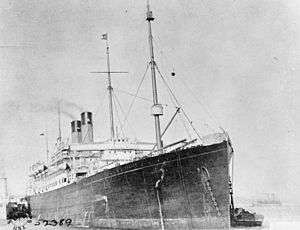RMS Celtic (1901)
RMS Celtic was an ocean liner owned by the White Star Line. The first ship larger than SS Great Eastern by gross register tonnage (it was also 9 feet (2.7 m) longer), Celtic was the first of a quartet of ships over 20,000 tons, dubbed The Big Four.[3]
 RMS Celtic in 1919. | |
| History | |
|---|---|
| Name: | RMS Celtic |
| Owner: | White Star Line |
| Route: | Liverpool - New York City |
| Builder: | Harland and Wolff, Belfast |
| Yard number: | 335 |
| Launched: | 4 April 1901 |
| Completed: | 11 July 1901 |
| Maiden voyage: | 26 July 1901 |
| Fate: | Ran aground on 10 December 1928, scrapped on site |
| General characteristics | |
| Tonnage: | 20,904 GRT[1] |
| Length: | 701 ft (214 m) |
| Beam: | 75 ft (23 m) |
| Installed power: | 14,000 ihp (10,000 kW) |
| Propulsion: |
|
| Speed: | 16 kn (18 mph; 30 km/h) |
| Capacity: |
|
History
Launch
Celtic was launched on 4 April 1901 from the Harland and Wolff shipyards in Belfast, and set off on her maiden voyage from Liverpool to New York City on 26 July.
She and her three sisters proved to be immensely popular with travelers, particularly immigrants. During the infamous 1904 Rate War she set the record for the highest number of passengers carried in a single crossing in White Star's history. She arrived in New York on 16 September fully booked with 2,957 passengers on board.
At the beginning of the First World War, Celtic was converted into an armed merchant cruiser; however since the vessel had a high fuel consumption it was decided to convert her into a troop ship in January 1916 when she was used to carry soldiers to Egypt. She was put back on the transatlantic route in March 1916.
Mine and torpedoing incidents
In 1917, Celtic struck a mine off the Isle of Man. Seventeen people on board were killed, but Celtic survived. A number of passengers were rescued by the London and North Western Railway ship Slieve Bawn. Celtic was towed to Peel Bay and repaired in Belfast. In March 1918, U-Boat UB-77 torpedoed Celtic in the Irish Sea. Six people on board were killed, but again Celtic remained afloat. Eventually the damaged vessel was towed to Liverpool and repaired again.
Post-World War I collisions
After the war, Celtic was involved in two collisions. The first incident occurred in 1925 while in the Mersey, when she accidentally rammed the Coast Line’s ship Hampshire Coast. Both vessels suffered only minor damage. The second collision took place on 29 January 1927, when Celtic was rammed in thick fog by the American Diamond Lines' Anaconda off Fire Island.[4][5]
Final demise
Early on 10 December 1928,[6] Celtic became stranded on the Cow and Calf rocks, adjacent to Roches Point as she approached Cobh with more than 200 passengers aboard. The Ballycotton Lifeboat T.P.Hearne 2, along with tugs, a destroyer and local life-saving teams, arrived. Tenders from Cobh disembarked the passengers.[7] Seven thousand tons of cargo were scattered. A salvage team from Cox and Danks was provided to attempt recovery, but several men died after a hold loaded with grain and flooded with seawater was found to have filled with toxic fumes; due to structural failures it was judged the ship could not be moved or salvaged, and was abandoned to the insurance company who declared the ship to be a total loss. Celtic was completely dismantled for scrap by 1933.[8]

References
Notes
- "Celtic (1113476)". Miramar Ship Index. Retrieved 22 September 2019.
- Arnold Kludas. Great Passenger Ships of the World Vol 1 1858-1912. Patrick Stephens Ltd. p. 90. ISBN 0-85059-174-0.
-
- Roberts, Chalmers (August 1901). "The Biggest Ship". The World's Work: A History of Our Time. II: 1176–1179. Retrieved 9 July 2009.
- White Star Line History Website: RMS Celtic
- oceanlinersmagazine.com Celtic Collision Archived 16 August 2016 at the Wayback Machine
- "Casualty reports". The Times (45073). London. 11 December 1928. col F, p. 23.
- Leach, Nicholas (2009). Ballycotton Lifeboats. Landmark. p. 32. ISBN 978-1-84306-472-5.
- Daniel Othfors. "Celtic II". The Great Ocean Liners. Retrieved 14 December 2008.
Bibliography
- Chirnside, Mark (2016). The 'Big Four' of the White Star Fleet: Celtic, Cedric, Baltic & Adriatic. Stroud, Gloucestershire: The History Press. ISBN 9780750965972.
- Osborne, Richard; Spong, Harry & Grover, Tom (2007). Armed Merchant Cruisers 1878–1945. Windsor, UK: World Warship Society. ISBN 978-0-9543310-8-5.
External links
| Wikimedia Commons has media related to Celtic (ship, 1901). |